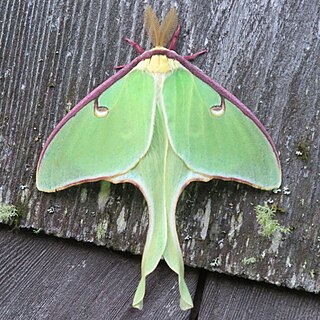
The Luna moth also known as the American moon moth is a Nearctic moth in the family Saturniidae, subfamily Saturniinae, a group commonly known as giant silk moths. It has lime-green colored wings and a white body. The larvae (caterpillars) are also green. Typically, it has a wingspan of roughly 114 mm (4.5 in), but can exceed 178 mm (7.0 in), making it one of the larger moths in North America. Across Canada, it has one generation per year, with the winged adults appearing in late May or early June, whereas farther south it will have two or even three generations per year, the first appearance as early as March in southern parts of the United States.

The beautiful demoiselle is a European damselfly belonging to the family Calopterygidae. It is often found along fast-flowing waters where it is most at home.
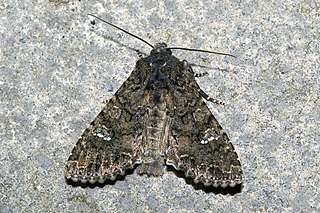
The cabbage moth is primarily known as a pest that is responsible for severe crop damage of a wide variety of plant species. The common name, cabbage moth, is a misnomer as the species feeds on many fruits, vegetables, and crops in the genus Brassica. Other notable host plants include tobacco, sunflower, and tomato, making this pest species particularly economically damaging.

Kallima inachus, the orange oakleaf, Indian oakleaf or dead leaf, is a nymphalid butterfly found in Tropical Asia from India to Japan. With wings closed, it closely resembles a dry leaf with dark veins and is a commonly cited example of camouflage.
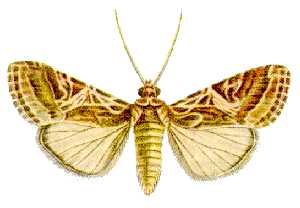
Spodoptera litura, otherwise known as the tobacco cutworm or cotton leafworm, is a nocturnal moth in the family Noctuidae. S. litura is a serious polyphagous pest in Asia, Oceania, and the Indian subcontinent that was first described by Johan Christian Fabricius in 1775. Its common names reference two of the most frequent host plants of the moth. In total, 87 species of host plants that are infested by S. litura are of economic importance. The species parasitize the plants through the larvae vigorous eating patterns, oftentimes leaving the leaves completely destroyed. The moth's effects are quite disastrous, destroying economically important agricultural crops and decreasing yield in some plants completely. Their potential impact on the many different cultivated crops, and subsequently the local agricultural economy, has led to serious efforts to control the pests.

Lyriothemis tricolor is a species of dragonfly in the family Libellulidae. It is found in Bangladesh, China, India, Japan, Myanmar, and Taiwan.

Peridroma saucia, the pearly underwing or variegated cutworm, is a moth of the family Noctuidae. The species was first described by Jacob Hübner in 1808. It is found in North and South America, Europe, Asia and Africa. The variegated cutworm feeds on many plants, especially common fruits and vegetables. The moth undergoes two to four generations per year. The development of the moth slows in colder temperatures, indicative of its migratory nature. All stages of the life cycle have a developmental threshold for temperature. The moth is known to migrate to the northern regions during warmer months, returning to the southern regions when the climate becomes colder.

Chloridea virescens, commonly known as the tobacco budworm, is a moth of the family Noctuidae found throughout the eastern and southwestern United States along with parts of Central America and South America.

Hippotion velox, the dark striated hawkmoth, is a species of sphingid moth or the family Sphingidae. The species was described by Johan Christian Fabricius in 1793.
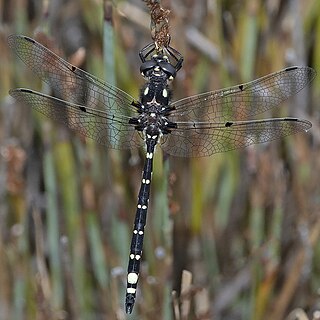
Synthemiopsis gomphomacromioides, also known as the Tasmanian spotwing, is a species of dragonfly from southern and north-western Tasmania, Australia. It is the only species in the genus Synthemiopsis and has also been placed in its own tribe, Synthemiopsini. R. J. Tillyard, who first described it, considered it intermediate between the Australian genus Synthemis and the Chilean Gomphomacromia. He had material from swamps around Cradle Mountain, at about 4,000 feet (1,200 m) altitude, and from Flowerdale Creek near Wynyard. Synthemiopsis gomphomacromioides flies rapidly over the swamps and often sits on reeds. It occurs together with Synthemis tasmanica, a similar but duller-coloured species.

Vestalis gracilis, is a species of damselfly belonging to the family Calopterygidae. It is known commonly as the clear-winged forest glory or clear-winged flash-wing. It is native to Southeast Asia and surrounding regions.

Cariblatta lutea is a small species of cockroach native to the United States and other countries, measuring usually around 7 millimeters long as an adult and under 2 millimeters from head tip to abdomen tip at the 1st instar or hatchling. It consists of two subspecies, the small yellow cockroach, and the least yellow cockroach.

Conosimus baenai is a species of planthopper native to the Iberian Peninsula in Spain. Its coloration ranges between light yellow and greenish-yellow. Males measure about 4.1–4.4 millimeters in length while females measure about 4.7–5.0 millimeters. The species was named after Manuel Baena, a hemipterologist.
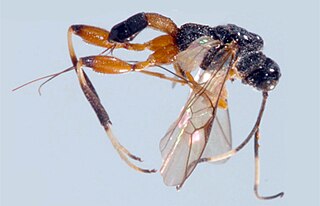
Spasskia brevicarinata is a species of parasitoid wasp native to the Guizhou and Yunnan provinces of China. The female body is 8.2 millimeters long, with 7.3 millimeter forewings. The ovipositor, when fully extended, measures 5.5 millimeters long. General coloration is black, however, the first tergite is yellow. The fore and mid legs are also yellow, while the hind pair are reddish-brown and whitish-yellow. The antennae are dark brown, with a whitish-yellow stripe between the 11th and 15th flagellomeres No males of the species have been observed to date. The species name is derived from Latin brevi, meaning "short" and carinata, the word for "carina". This literally means that the species has a short dorsal carinae as part of the first tergite.

Diprion similis is a species of sawfly in the family Diprionidae. It is native to central and northern Europe and Asia but has been accidentally introduced into North America where it has become invasive. The larvae feed on the needles of pine trees, especially those of the white pine. In North America it is known as the introduced pine sawfly or the imported pine sawfly. It is also known as the white pine sawfly because of its preference for feeding on the white pine, but this name is confusing because another sawfly, Neodiprion pinetum, whose larvae also feed on this tree, is itself known as the "white pine sawfly".
Pseuduvaria pamattonis is a species of plant in the family Annonaceae. It is native to Borneo and the Philippines. Friedrich Miquel, the Dutch botanist who first formally described the species using the basionym Orophea pamattonis, named it after a mountain in Borneo called Gunung Pamaton.
Abscondita chinensis, is a species of firefly beetle found in India, China and Sri Lanka.
Sphegina (Asiosphegina) bispinosa is a species of hoverfly in the family Syrphidae found in India, Nepal, and Bhutan. It's similar to S. (A.) hansoni, but easily differentiated by the strongly asymmetrical surstyli.
Sphegina guptai is a species of hoverfly in the family Syrphidae found in India. It's similar to S. elegans in general appearance and characters of the male genitalia. It differs from known Oriental species of Sphegina by the shiny black abdomen with widened terga III and IV. Only S. quadrisetae has a somewhat similar appearance.

Tetracanthagyna plagiata, the giant hawker or the gigantic riverhawker, is a species of dragonfly in the family Aeshnidae. It is found throughout Sundaland, having been recorded on Thailand, Peninsular Malaysia, Singapore, Sumatra, and Borneo. It is the type species for the genus Tetracanthagyna.
















